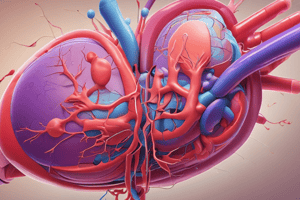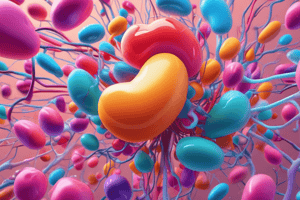Podcast
Questions and Answers
What class of drug is procainamide?
What class of drug is procainamide?
Sodium channel blocker
What is the mechanism of action (MOA) of procainamide?
What is the mechanism of action (MOA) of procainamide?
Block sodium ion channels in myocardial cells, reducing automaticity and slowing conduction of the action potential across the myocardium.
What is the most common route of administration for procainamide?
What is the most common route of administration for procainamide?
Oral XL
What are the routes available for procainamide? (Select all that apply)
What are the routes available for procainamide? (Select all that apply)
What are the therapeutic levels of procainamide?
What are the therapeutic levels of procainamide?
What are common adverse effects of procainamide?
What are common adverse effects of procainamide?
What is the black box warning associated with procainamide?
What is the black box warning associated with procainamide?
What are the contraindications for procainamide?
What are the contraindications for procainamide?
What laboratory levels might procainamide increase?
What laboratory levels might procainamide increase?
What is the treatment for procainamide overdose?
What is the treatment for procainamide overdose?
Flashcards are hidden until you start studying
Study Notes
Procainamide Overview
- Class: Sodium channel blocker, effective for specific cardiac conditions.
Mechanism of Action (MOA)
- Blocks sodium ion channels in myocardial cells.
- Reduces automaticity and slows conduction of the action potential throughout the myocardium.
- Results in slight delay in conduction, prolonging the refractory period, beneficial for suppressing dysrhythmias.
- Broad-spectrum efficacy for various atrial and ventricular dysrhythmias.
Uses
- Indicated primarily for life-threatening dysrhythmias.
Administration Routes
- Most common: Oral Extended-Release (XL).
- Other options: Intravenous (IV) and Intramuscular (IM).
Therapeutic Levels
- Target range: 4-8 mcg/ml for effective treatment.
Adverse Effects
- Common: Nausea, vomiting, abdominal pain, hypotension (HOTN), headache (HA).
- High doses potentially cause central nervous system (CNS) issues like confusion and psychosis.
Black Box Warning
- Prolonged use may trigger antinuclear antibodies (ANA).
- Risk of lupus-like syndrome in 30-50% of patients on long-term therapy.
- Usage should be limited to life-threatening dysrhythmias due to the potential to introduce new dysrhythmias or exacerbate existing ones.
- Associated risks include agranulocytosis and bone marrow depression.
Contraindications
- Not recommended for patients with severe atrioventricular (AV) block, severe heart failure (HF), blood dyscrasias, and myasthenia gravis.
Lab Interactions
- May elevate enzyme levels: AST, ALT, alkaline phosphatase, LDH, and serum bilirubin.
- Possible false positive results for Coombs tests and ANA titers.
Overdose Treatment
- Hypotension resulting from overdose can be reversed using vasopressors.
Studying That Suits You
Use AI to generate personalized quizzes and flashcards to suit your learning preferences.




